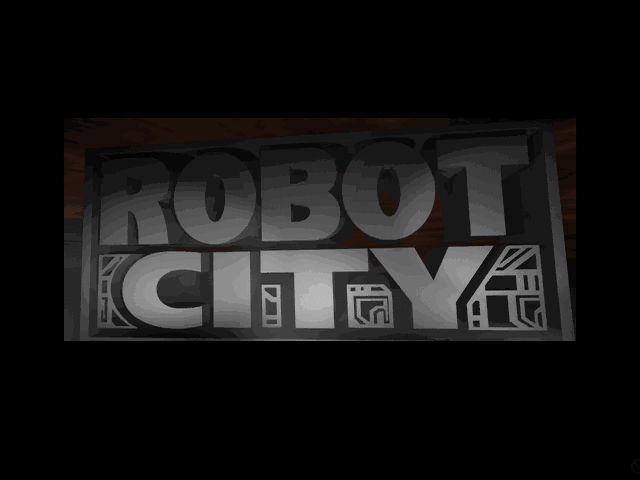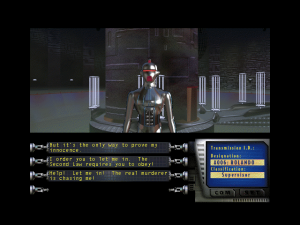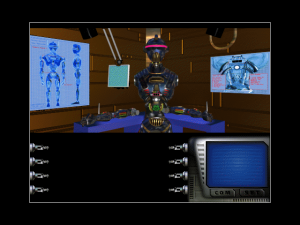Robot City 
Even people who have never read an Asimov story know of his famed Three Laws of Robotics, so ubiquitous that it would be redundant to list them. Asimov’s robots took on life and popularity beyond his novels and short stories, which eventually led the author to commission a series of books based on his famous motifs. The Robot City series acted almost like a perfunctory exercise in testing the Laws of Robotics in extreme circumstances, but it at least did so in the dressings of a murder mystery.
The game adaptation of Robot City is inherently more interesting. The game mines a surprising level of narrative intrigue out of the Three Laws, chiefly because you can interact with the robots rather than just reading about their reactions. In the process, Robot City nearly perfects the art of the dialogue puzzle. So let’s never speak of the devastatingly slow exploration sequences tucked in-between the puzzles.
…I suppose that now we have to, huh?
Robot City is set in the distant future on a deserted planet populated and governed by Asimovian androids. You play as “Derec,” an amnesiac who crash-lands there and is immediately framed for the death of Dr. Poole, one of the other few visiting humans. While under house arrest, you meet fellow human Katherine and the robot sidekick Alpha, who both offer their assistance to help you get to the bottom of the unsolvable murder mystery. Thus begins a sprawling quest through Robot City as you gather clues and evidence while eluding the authorities desperate to hide a dark secret about their society.
The game plays similarly to other first-person adventure games but with a strong emphasis on dialogue rather than inventory collection. As with any good mystery story protagonist, you spend much of your time interrogating witnesses, cross-examining evidence, and discussing the findings with your Watson stand-in. The writing is taut and evenly paced, with conversations proceeding naturally and logically. I can’t understate how rare that is in adventure games, especially ones from the 90s. Not once did I feel that the game led me towards a certain train of thought; my inclinations about guilty parties, evidence, and the next course of action seemed to inform the dialogue and not vice versa.
The big cast emphasizes the game’s strengths by playing with established character types. You’ll encounter a number of interesting robots apart from Alpha’s role as the subservient foil. There’s the Supervisors, who are obliged to answer your questions with begrudging stoicism when they aren’t busy, or the citizens who stop you on the street when they notice that you don’t quite fit in. Rather than coming off like talking to pre-scripted exposition dispensers, interactions with the robots evolve into a game of mental rock-paper-scissors in which you judge their patience and find their breaking point. Conversations have an air of detached logic that, counter-intuitively, makes them more approachable and engaging.
These interrogations and deduction puzzles are held together by the open-world adventure segments. Taking cues from other mystery and adventure games, Robot City has a massive overworld full of one-off characters, clues, and hidden shortcuts.
And here, the whole game falls apart.
Robot City‘s asks you to prove your innocence and leaves you several ways to amass the evidence. To get the proper ending, you need to gather Dr. Poole’s diaries, find the Key to Perihelion, and meet all the key witnesses (among other plot-important events, such as winning a fast-paced underground train minigame). As with most adventure games, you reach these goals by exploring all the nooks and crannies of Robot City. Some areas are unlocked via the subway system, while others need to be discovered on the streets.
The titular city is wildly unstable, with streets collapsing and reforming rapidly. This drives much of the late-stage plot, but the developers decided to integrate it into the gameplay as well and basically ruin the entire product. Since the structure of the city changes, its layout is continuously randomly regenerated. If you need to find a specific sector, it is impossible to locate it – or to find your way back once you’re there! Train stations give you a quick path to key areas you’ve already visited, but they’re located randomly too, as are the items and suspects you’re looking for? On my second playthrough, I still spent hours wandering the streets without knowing where I was or how to reach my destination.
Rearranged layouts and item placement can be a clever way to add longevity, but complete randomness and instability suck the life out of the exploratory parts of the game. The city’s confusing layout and architecture are menacing at first, in a way that encourages you to peek around the corner before going on. Once you realize the trick Robot City is playing on you, there is no joy or thrill in exploring. Getting lost is no fun when the game is lost too.
Plus, all that aimless wandering can cost you permanently. If you walk around too much in the acid rain, or if the the police’s Hunter-Killer robots find you (automatic after a certain period of time), you lose the equivalent of a “life,” which can only happen a few times before you lose entirely. It seems grossly unfair to punish the player for having to stumble through a random level generator.
It’s such a shame because Robot City could have been a sci-fi adventure classic. If you enjoy 90s sci-fi in the style of The Journeyman Project or The Fifth Element, I’d recommend the game regardless of its faults. The city evokes Metropolis-esque dystopian, oppressive modernism, while the interface recalls the rounded, shiny future from Men in Black. The game wrings a wealth of visual quality out of its technical limitations and repetition, such as the subway rides, which still look impressive after the twentieth time their cutscene replays. The soundtrack oozes with that pulpy synthesizer sound from the Logan’s Run era. Alpha is the perfect sidekick for the setting, and the mystery plot takes unexpected but logical twists all the way up to the last room. As a game adaptation, it has a major leg up on the novels, in that it makes the player experience and understand the dread, confusion, and high stakes of the conflict first-hand.
But as it is, Robot City is damaged goods. As an interactive Asimovian exercise, and as a detective thriller, it succeeds. But the gameplay infrastructure holding those parts together utterly disintegrates the first moment you notice its cracks. The highs are memorable, but the lows aren’t just bad: they’re off-putting and boring.




